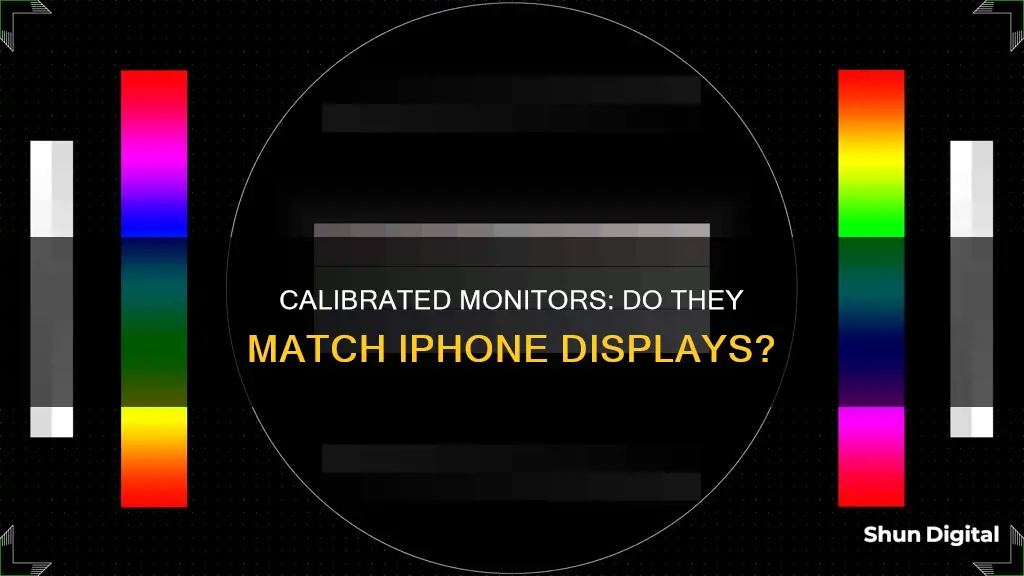
Many factors can affect how you perceive colours on your display, such as ambient light, the position and angle of the display, and the age of the display. While it is possible to calibrate a monitor to match an iPhone display, it is challenging due to the differences in display types and colour spaces. Newer monitors can get closer to matching the P3 colour space, which is Apple's choice for colour science. However, iPhones have True Tone technology, which shifts the white balance depending on the ambient light, making it difficult to take a precise measurement.
| Characteristics | Values |
|---|---|
| Calibration | Display Calibrator Assistant, Pro Display Calibrator |
| Calibration Process | Adjusting display, creating a calibrated color profile |
| Calibration Factors | Ambient light, display position, display angle, display age |
| Calibration Tools | Colorimeter, Spyder, Xrite, DisplayCal, i1DisplayPro |
| Calibration Settings | Temp 6500K, 120-140cd/m2, gamma 2.2, 5000-5500K, 7000+K CDT |
| Calibration Considerations | Color management, color profile, color accuracy, color space, white point, gamma, primaries, luminance |
| Devices | iPhone 5, 6, 7, 8, XS, iPad, MacBook, Mac, PC, iOS devices |
What You'll Learn

Calibration of monitors to match iPhone screens
Understanding Display Calibration
Firstly, it's important to understand that display calibration is the process of adjusting a monitor's settings to achieve accurate and consistent colour reproduction. This is particularly important for professionals in fields such as photography, graphic design, and video editing, where colour accuracy is crucial. By calibrating your monitor, you can ensure that the colours displayed on your screen closely match the colours of the original image or source.
Differences Between Monitors and iPhone Screens
Monitors and iPhone screens use different display technologies, which can make calibration challenging. Most modern iPhones use OLED screens, which offer a wider colour gamut, higher contrast ratios, and perfect black levels compared to traditional LCD monitors. Additionally, iPhones have a feature called True Tone, which adjusts the white balance of the display based on the ambient lighting conditions. This dynamic nature of iPhone screens makes it difficult to match them exactly with a static monitor calibration.
Steps to Calibrate Your Monitor to Match iPhone Screens
- Use a Colour Management System: Both macOS and iOS have built-in colour management systems that aim to provide accurate colour reproduction. On your Mac, you can use the Display Calibrator Assistant to adjust your display settings. Go to System Settings > Displays, click on the display you want to calibrate, and select "Calibrate Display". This will guide you through the calibration process.
- Match Colour Spaces: iPhone screens typically use the P3 colour space, which has a wider gamut than the standard sRGB colour space used by many monitors. By calibrating your monitor to the P3 colour space, you can get closer to the colours displayed on your iPhone.
- Use a Colourimeter: A colourimeter is a device that measures the colour output of a display. You can use a colourimeter like the X-Rite i1 Display Pro to capture the colour profile of your iPhone screen and then attempt to match it on your monitor. This method may not yield perfect results, but it can help you get closer.
- Consider Hardware Limitations: Keep in mind that your monitor may have hardware limitations that prevent it from matching the colour gamut or brightness of an iPhone screen perfectly. For example, if your monitor does not support hardware calibration or does not have a wide colour gamut, you may not be able to achieve an exact match.
- Use a Wide-Gamut Monitor: If colour accuracy is critical for your work, consider investing in a wide-gamut monitor that can more closely match the colour capabilities of iPhone screens. Look for monitors that support hardware calibration and have a high colour accuracy specification.
- Soft-Proofing: If you are unable to match your monitor to your iPhone screen exactly, you can use soft-proofing techniques in photo editing software like Photoshop. This involves simulating the colour profile of your iPhone screen on your monitor, allowing you to preview how your images will look on an iPhone display.
While it may not be possible to achieve a perfect match between a calibrated monitor and an iPhone screen due to differences in display technologies and colour management systems, the steps outlined above can help you get as close as possible. Remember that colour accuracy is important for ensuring consistency in your work, especially if you are in a creative field. By taking the time to calibrate your displays, you can improve the overall quality and accuracy of your visual projects.
Removing Micromax Monitor Stand: A Step-by-Step Guide
You may want to see also

Display Calibrator Assistant
Display Calibration Assistant is a feature on macOS that helps users adjust their display settings to achieve the desired colour accuracy. It is particularly useful for graphic design or video editing work, where custom calibration is often required.
To access the Display Calibrator Assistant, go to the Apple menu > System Settings and click on Displays in the sidebar. From here, you can open the Display Calibrator Assistant by clicking on the colour profile and selecting "Customize".
The Display Calibrator Assistant will guide you through the process of adjusting your display settings. It will then create a calibrated colour profile for your display. The number of adjustments will vary depending on the type of display you are using. Once the display profile is ready, it will automatically be assigned as the colour profile for your display.
It is important to note that calibrating your display is usually not necessary for a Mac in a typical home or office environment. Additionally, different displays may have their own built-in colour accuracy and calibration features, so it is recommended to refer to the documentation that came with your display for more specific instructions.
If you are using an Apple Pro Display XDR, Apple Studio Display, or a MacBook Pro (2021 or later), you can also use the Pro Display Calibrator for more advanced calibration options. This includes recalibrating the white point, primaries, luminance, and gamma response of your display.
Achieving an exact match between a calibrated monitor and an iPhone display can be challenging due to differences in display technologies and colour spaces. However, by using tools like DisplayCAL and colourimeters, it is possible to get closer to matching the colour calibration of iOS devices.
Positioning Studio Monitors: Optimal Height for Best Sound
You may want to see also

Calibration of monitors to match iPad screens
Calibration of monitors is a common practice to ensure accurate colour representation. While it is possible to calibrate a monitor to match an iPad screen, it is not recommended. This is because iPad screens are generally well-calibrated and already adhere to a standard colour space. Additionally, iPad screens feature True Tone technology, which adjusts the white balance according to the ambient light, so attempting to calibrate a monitor to match an iPad screen may worsen the calibration.
Instead, it is advised to calibrate monitors to a standard colour space, such as sRGB, which is the standard for internet content. For Apple devices, P3 is a closer colour space, with P3 D65 being Apple's version, although this uses an encoding sRGB compound gamma, which is considered incorrect.
If calibration to an iPad screen is still desired, a colourimeter can be used to measure the iPad screen's colour profile, which can then be applied to the monitor. However, this may result in inaccurate colour representation on the monitor, as it will no longer be calibrated to a standard colour space.
To calibrate an iPad screen, the device must be one of the following:
- IPad Pro 13-inch (M4)
- IPad Pro 11-inch (M4)
- IPad Pro 12.9-inch (5th or 6th generation)
The device must also have Reference Mode enabled, which can be done by going to Settings > Display & Brightness > Advanced > Reference Mode. Reference Mode ensures accurate colours and consistent image quality, and it disables dynamic display adjustments like True Tone and Auto-Brightness. Fine-Tune Calibration can then be used to adjust the white point and luminance to match specific targets.
In summary, while it is technically possible to calibrate a monitor to match an iPad screen, it is not recommended due to the potential for inaccurate colour representation. Instead, calibrating to a standard colour space is the preferred method to ensure consistent and accurate colours across devices.
Blind Spot Monitor: Is It Standard on the Toyota Prius?
You may want to see also

Calibration of monitors to match MacBook screens
For dual-monitor setups on Mac OS X systems, the "Multiple Monitor Features" can be activated by going to "System Preferences -> Displays" and pressing "Detect Displays". It is important to uncheck the "Mirror Displays" option during the calibration process. The ColorMunki software can then be used to calibrate and profile each monitor individually.
In terms of matching MacBook screens, it is worth noting that Apple uses a version of the P3 colour space, which is similar to AdobeRGB. Therefore, calibrating monitors to match MacBook screens can be achieved by calibrating to the P3 colour space. However, Apple's implementation of P3 uses an sRGB compound gamma, which is considered incorrect by some.
Additionally, it is important to consider that different iPhone models have different white points, and iPhones use OLED screens, whereas most monitors do not. This makes it challenging to calibrate a monitor to match an iPhone screen exactly.
For accurate colour calibration, it is recommended to use colourimeters or colorimeters, such as the X-Rite i1 Display Pro or the Data Color Spyder. These tools can help ensure that monitors are calibrated to the correct colour space and white point.
Overall, while it may not be possible to achieve an exact match between a calibrated monitor and a MacBook screen, following the steps outlined above can help ensure that colours are displayed accurately and consistently across different devices.
Monitoring Sustainability Performance: Strategies for Success
You may want to see also

Calibration of monitors to match Apple device displays
To calibrate a monitor to match an Apple device, you will need a colourimeter or a spectroradiometer. These devices allow you to measure the colour accuracy of your display and make adjustments accordingly. Some recommended colourimeters include the X-Rite i1 Display Pro, the Data Color Spyder, and the Spyder or Xrite with DisplayCal.
Once you have the appropriate tools, the next step is to measure the colour profile of the Apple device you want to match. This can be done using software such as DisplayCal, which will allow you to capture the calibration of the device. For iOS devices, it is important to note that they cannot be natively calibrated, but it is assumed that they all show the same colours. Therefore, measuring the colour profile of one iOS device should give you a good starting point for calibration.
After measuring the colour profile of the Apple device, you will need to adjust the settings on your monitor to match. This can be done through your operating system's display settings, which can usually be found in the System Settings or Control Panel. Look for options such as "Colour Profile" or "Calibrate Display". From here, you can adjust the settings to match the measurements you took from the Apple device, including the white point, luminance, gamma response, and RGB primaries.
It is important to keep in mind that not all monitors are capable of reproducing the exact same colours as Apple devices, especially if they have different display technologies (e.g. OLED vs LCD). Additionally, Apple devices use a flavour of DCI-P3 colour space, which may be difficult to replicate exactly on a standard monitor.
Finally, it is recommended to calibrate your monitor to a general standard rather than trying to match it exactly to an Apple device. This will ensure that your monitor displays colours accurately for a variety of content, not just Apple devices.
Monitoring Solar Power Usage: A Comprehensive Guide
You may want to see also
Frequently asked questions
Yes, it is possible to calibrate a monitor to match an iPhone. However, it is important to note that iPhone models use different white points and some iPhones use OLED screens, while monitors typically do not.
You can use a colorimeter, such as the X-Rite i1 Display Pro, in conjunction with software like DisplayCAL to calibrate your monitor to match your iPhone.
The settings will depend on the specific iPhone model and monitor being used. Basic settings include Temp 6500K, 120-140cd/m2, and gamma 2.2. For iPhone models with OLED screens, settings between 5000-5500K may be more appropriate.
Calibrating your monitor to match your iPhone ensures that images processed on your computer will appear as intended when viewed on your iPhone. This is particularly important for photographers, artists, and mobile developers.
Yes, you can use a wide-gamut monitor with hardware calibration to match the colour profile of your iPhone. Additionally, you can use software like Photoshop to soft-proof your images for a specific iPhone model.







